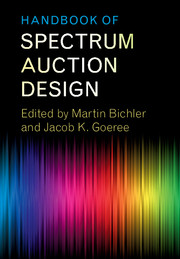Book contents
- Frontmatter
- Contents
- List of Contributors
- Preface
- List of Papers
- Part I The Simultaneous Multiple-Round Auction
- Part II The Combinatorial Clock Auction Designs
- Part III Alternative Auction Designs
- Part IV Experimental Comparisons of Auction Designs
- Part V The Bidders’ Perspective
- Part VI Secondary Markets and Exchanges
- 36 Spectrum Markets: Motivation, Challenges, and Implications
- 37 Designing the US Incentive Auction
- 38 Solving the Station Repacking Problem
- 39 ICE: An Expressive Iterative Combinatorial Exchange
- 40 ACE: A Combinatorial Market Mechanism
- Outlook
- References
38 - Solving the Station Repacking Problem
from Part VI - Secondary Markets and Exchanges
Published online by Cambridge University Press: 26 October 2017
- Frontmatter
- Contents
- List of Contributors
- Preface
- List of Papers
- Part I The Simultaneous Multiple-Round Auction
- Part II The Combinatorial Clock Auction Designs
- Part III Alternative Auction Designs
- Part IV Experimental Comparisons of Auction Designs
- Part V The Bidders’ Perspective
- Part VI Secondary Markets and Exchanges
- 36 Spectrum Markets: Motivation, Challenges, and Implications
- 37 Designing the US Incentive Auction
- 38 Solving the Station Repacking Problem
- 39 ICE: An Expressive Iterative Combinatorial Exchange
- 40 ACE: A Combinatorial Market Mechanism
- Outlook
- References
Summary
Introduction
Over 13 months in 2016–17, the US government held an innovative “incentive auction” for radio spectrum, in which television broadcasters were paid to relinquish broadcast rights via a “reverse auction”, remaining broadcasters were repacked into a narrower band of spectrum, and the cleared spectrum was sold to telecommunications companies. The stakes were enormous: the auction was forecast to net the government tens of billions of dollars, as well as creating massive economic value by reallocating spectrum to more socially beneficial uses (Congressional Budget Office 2015). As a result of both its economic importance and its conceptual novelty, the auction has been the subject of considerable recent study by the research community, mostly focusing on elements of the auction design (Bazelon, Jackson, and McHenry 2011; Kwerel, LaFontaine, and Schwartz 2012; Milgrom et al. 2012; Calamari et al. 2012; Marcus 2013; Milgrom and Segal 2014; Dütting, Gkatzelis, and Roughgarden 2014; Vohra 2014; Nguyen and Sandholm 2014; Kazumori 2014). After considerable study and discussion, the FCC has selected an auction design based on a descending clock (FCC 2014c; 2014a). Such an auction offers each participating station a price for relinquishing its broadcast rights, with this price offer falling for a given station as long as it remains repackable. A consequence of this design is that the auction must (sequentially!) solve hundreds of thousands of such repacking problems. This is challenging, because the repacking problem is NP-complete. It also makes the performance of the repacking algorithm extremely important, as every failure to solve a single, feasible repacking problem corresponds to a lost opportunity to lower a price offer. Given the scale of the auction, individual unsolved problems can cost the government millions of dollars each.
This chapter shows how the station repacking problem can be solved exactly and reliably at the national scale. It describes the results of an extensive, multi-year investigation into the problem, which culminated in a solver that we call SATFC.
- Type
- Chapter
- Information
- Handbook of Spectrum Auction Design , pp. 813 - 827Publisher: Cambridge University PressPrint publication year: 2017



